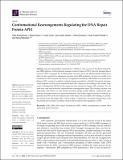Files in this item
Conformational rearrangements regulating the DNA repair protein APE1
Item metadata
| dc.contributor.author | Komaniecka, Nina | |
| dc.contributor.author | Porras, Marta | |
| dc.contributor.author | Cairn, Louis | |
| dc.contributor.author | Santas, Jon Ander | |
| dc.contributor.author | Ferreiro, Nerea | |
| dc.contributor.author | Penedo , Carlos | |
| dc.contributor.author | Banuelos, Sonia | |
| dc.date.accessioned | 2022-08-09T15:30:01Z | |
| dc.date.available | 2022-08-09T15:30:01Z | |
| dc.date.issued | 2022-07-20 | |
| dc.identifier | 280759358 | |
| dc.identifier | 951c7319-d3ca-4968-b0f3-c368d5f6102a | |
| dc.identifier | 000833680200001 | |
| dc.identifier | 85136432376 | |
| dc.identifier.citation | Komaniecka , N , Porras , M , Cairn , L , Santas , J A , Ferreiro , N , Penedo , C & Banuelos , S 2022 , ' Conformational rearrangements regulating the DNA repair protein APE1 ' , International Journal of Molecular Sciences , vol. 23 , no. 14 , 8015 . https://doi.org/10.3390/ijms23148015 | en |
| dc.identifier.issn | 1661-6596 | |
| dc.identifier.other | ORCID: /0000-0002-5807-5385/work/116910400 | |
| dc.identifier.uri | https://hdl.handle.net/10023/25802 | |
| dc.description | This research was funded by the University of the Basque Country (grant number GIU18/172). The APC was funded by the Basque Government (grant number IT1454‐22). | en |
| dc.description.abstract | Apurinic apyrimidinic endonuclease 1 (APE1) is a key enzyme of the Base Excision Repair (BER) pathway, which primarily manages oxidative lesions of DNA. Once the damaged base is removed, APE1 recognises the resulting abasic site and cleaves the phosphodiester backbone to allow for the correction by subsequent enzymes of the BER machinery. In spite of a wealth of information on APE1 structure and activity, its regulation mechanism still remains to be understood. Human APE1 consists of a globular catalytic domain preceded by a flexible N-terminal extension, which might be involved in the interaction with DNA. Moreover, the binding of the nuclear chaperone nucleophosmin (NPM1) to this region has been reported to impact APE1 catalysis. To evaluate intra- and inter-molecular conformational rearrangements upon DNA binding, incision, and interaction with NPM1, we used Förster resonance energy transfer (FRET), a fluorescence spectroscopy technique sensitive to molecular distances. Our results suggest that the N-terminus approaches the DNA at the downstream side of the abasic site and enables the building of a predictive model of the full-length APE1/DNA complex. Furthermore, the spatial configuration of the N-terminal tail is sensitive to NPM1, which could be related to the regulation of APE1. | |
| dc.format.extent | 14 | |
| dc.format.extent | 706669 | |
| dc.language.iso | eng | |
| dc.relation.ispartof | International Journal of Molecular Sciences | en |
| dc.subject | APE1 | en |
| dc.subject | BER | en |
| dc.subject | DNA repair | en |
| dc.subject | Fluorescence | en |
| dc.subject | FRET | en |
| dc.subject | NPM1 | en |
| dc.subject | Nucleophosmin | en |
| dc.subject | Protein-DNAm interaction | en |
| dc.subject | Protein structure | en |
| dc.subject | QD Chemistry | en |
| dc.subject | QH426 Genetics | en |
| dc.subject | NDAS | en |
| dc.subject | MCC | en |
| dc.subject.lcc | QD | en |
| dc.subject.lcc | QH426 | en |
| dc.title | Conformational rearrangements regulating the DNA repair protein APE1 | en |
| dc.type | Journal article | en |
| dc.contributor.institution | University of St Andrews. School of Physics and Astronomy | en |
| dc.contributor.institution | University of St Andrews. Centre for Biophotonics | en |
| dc.contributor.institution | University of St Andrews. Biomedical Sciences Research Complex | en |
| dc.identifier.doi | 10.3390/ijms23148015 | |
| dc.description.status | Peer reviewed | en |
This item appears in the following Collection(s)
Items in the St Andrews Research Repository are protected by copyright, with all rights reserved, unless otherwise indicated.

